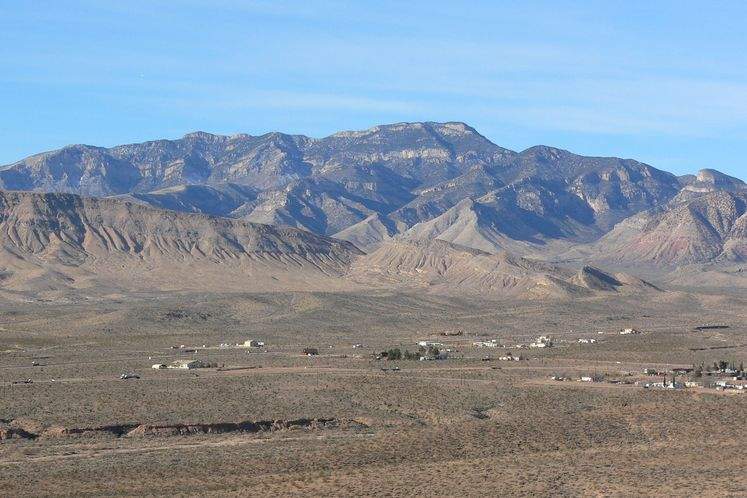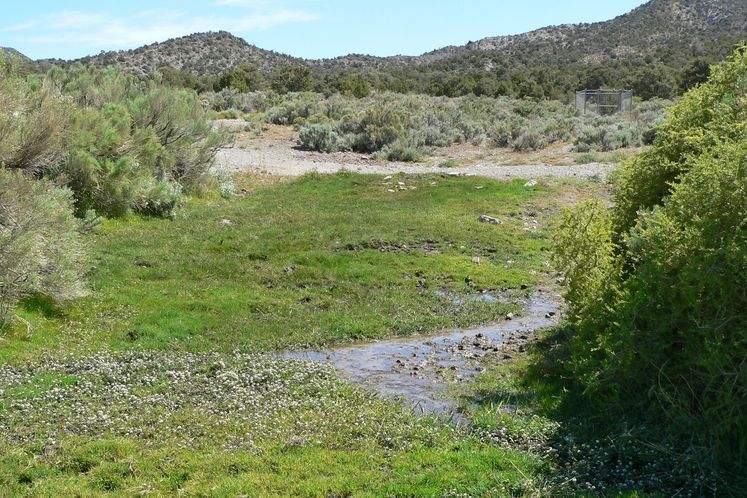
Potosi Mountain

"Mount Potosi seen from the east" by Stan Shebs is licensed under CC BY-SA 3.0.

"Potosi Mining District" by Stan Shebs is licensed under CC BY-SA 3.0.

Photograph of Potosi Mine, Nevada, circa early to mid 1900s. Elbert Edwards Photo Collection. UNLV Libraries Special Collections & Archives. Original cropped by The Historic Las Vegas Project.

"Potosi Spring" by Stan Shebs is licensed under CC BY-SA 3.0.
"The desire of local Mormon settlers for economic self-sufficiency led to mining by missionaries for lead at Potosí. In 1858, Nathaniel V. Jones was sent to recover ore from the “mountain of lead” 30 miles southwest of the mission at Las Vegas Springs. About 9,000 lbs. were recovered before smelting difficulties forced the remote mine to be abandoned in 1857. Potosi became the first abandoned mine in Nevada.
In 1861, California mining interests reopened the mine, and a smelter and rock cabins for 100 miners made up the camp of Potosi. Even more extensive operations resulted after the transcontinental Salt Lake and San Pedro R.R. (now the union pacific) was built through the county in 1905.
During World War I, Potosi was an important source of zinc."
(Nevada Historical Marker 115)
"Originally located in April 1856, when a Paiute Indian showed Mormon miners where "heavy rock" could be found, the Potosi Mine is the oldest in southern Nevada. Opened under the direction of Nathaniel V. Jones, it operated until January 1857, when the first effort ended. The lead was too brittle for bullets due to the high zinc and silver content. By 1861, the mine was being worked by the Colorado Mining Company, but this also only lasted a few years.
With the early twentieth century mining boom in the Goodsprings area, the Potosi was reopened. In 1913, the Empire Zinc Company bought the mine, building an aerial tram and baby gauge railroad to the site. By 1915, the Potosi mine was the largest zinc producer in Nevada, in addition to significant amounts of lead and silver. Production ended about 1930."
(Queho Posse Chapter 1919 E Clampus Vitus)
"On January 16th, 1942 TWA flight 3 Crashed into Potosi Mountain Nevada carrying 22 passengers. Among those passengers was American film star Carol Lombard, wife of actor Clark Gable. The actress was returning from a War Bond Tour in the Midwest and the plane a brief refueling stop at the Las Vegas Army Airfield, (now Nellis Air Force Base). The plane took off from Nellis Air Force base in Las Vegas and within 15 minutes the plane was off course by almost seven miles crashing into the vertical cliff on Potosi Mountain killing all on board. Shortly after the crash Clark Gable arrived in Goodsprings. There he waited and mourned at the local saloon while authorities retrieved the remains and belongings of his late wife. It was determined that the cause of the crash was due to an error in the navigational coordinates. Some speculate the pilots used coordinates meant for flying out of the Boulder Airport."
(Bureau of Land Management)
Listed on the National Register of Historic Places in 1974.